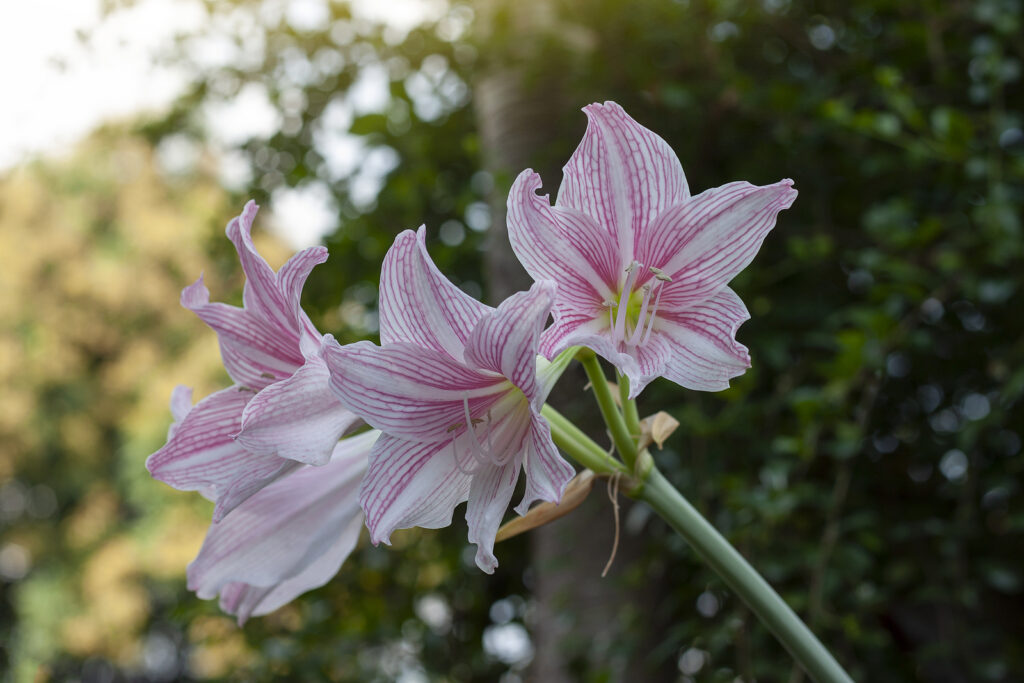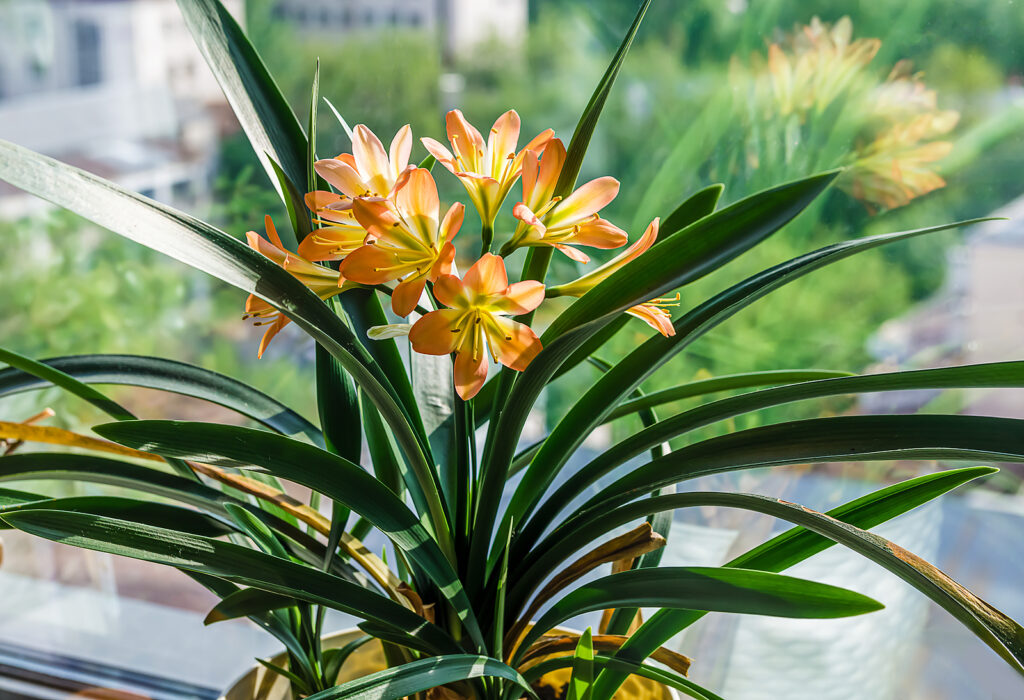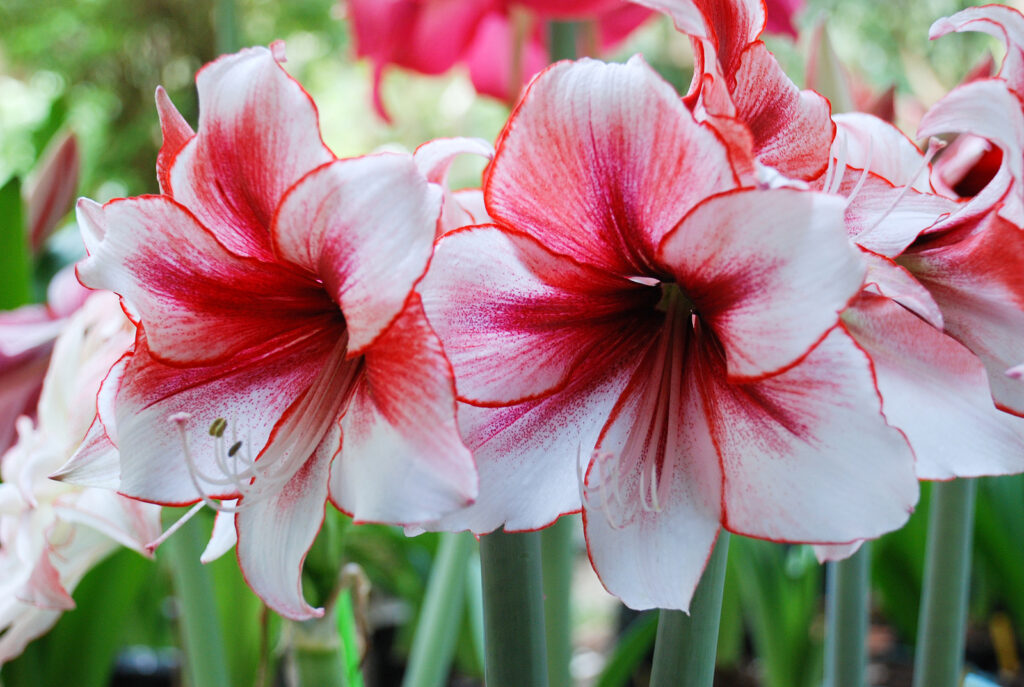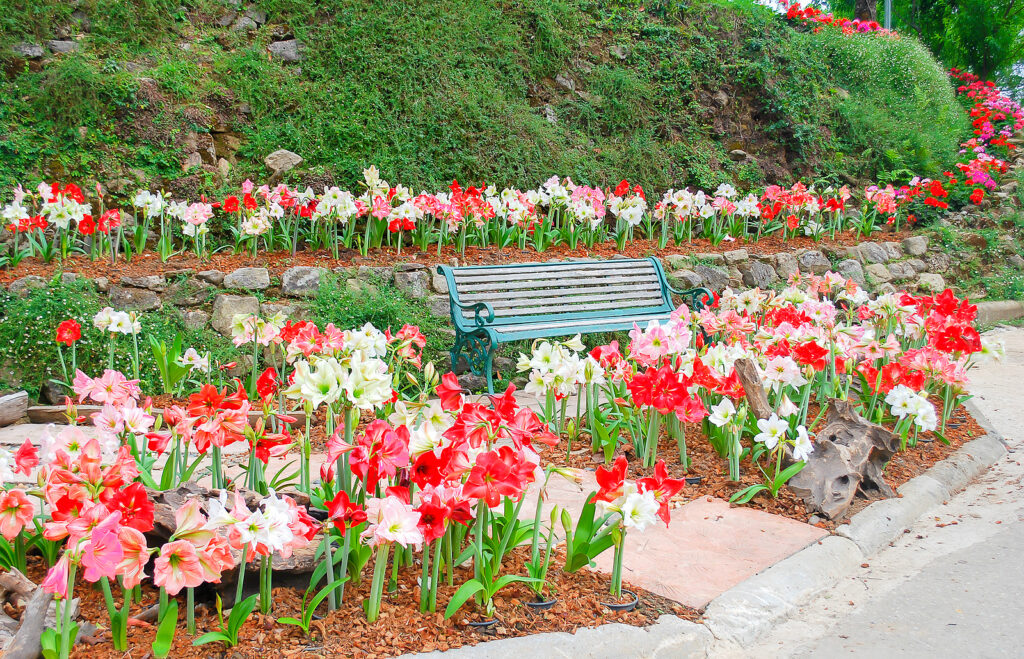Hippeastrum–commonly called Amaryllis–is a tropical native. It produces blooms up to 8 inches (20cm) across in a wide range of colors, with some varieties in double form. A baseball-size bulb produces flower stalks up to a foot tall surrounded by rich, green strap-like foliage.
Hippeastrum is often confused with Amaryllis belladonna. Both are large bulbs that produce trumpet-like flowers on thick stalks. The most popular and most commonly seen is Hippeastrum. Hippeastrum is commonly sold as “Amaryllis”–these amaryllises are Hippeastrum hybrids that can be orange, purple, white, pink, red, and sometimes edged or striped in other colors. Hippeastrum hybrids have hollow stalks and 3 to 6 flowers per cluster. Amaryllis belladonna has solid stalks and 6 to 12 flowers per cluster. Hippeastrum blooms in winter or spring; amaryllis belladonna blooms in autumn.
Hippeastrum can be forced to bloom; in bright indirect light and warm indoor temperatures; it will typically bloom in about 4 weeks. Plant the bulb in a container at least one inch larger in diameter than the bulb using a general potting soil, placing it pointed end up, with ½ of the tip exposed. Once blooms emerge, remove the plant to a low-light area. Keep the plant cool when it is in bloom so the flowers last longer.

Get to know Hippeastrum Amaryllis
- Plant type: Subtropical perennial bulb
- Growing Zones and range: Zones 7-10 outdoors
- Hardiness: Tender; warm conditions: 70°F (21°C) days and 60°F (16°C) nights
- Height and width: 1 to 3 feet (30-76cm) tall and nearly as wide
- Foliage: Slightly arching, strappy leaves emerge from baseball size bulbs; leaves may appear with or after the flowers.
- Flowers: Spectacular large 6 to 12-inch (15-30cm) trumpet-like flowers in white, pink, salmon, or red; blooms from atop a hollow stalk; some blooms are patterned or striped. Up to four blooms appear on each 18-inch stem.
- Bloom time: Mid-winter or spring for 4 weeks
- Uses: Houseplant
- Common name: Amaryllis
- Botanical name: Hippeastrum spp.
- Family: Amaryllidaceae
- Origin: Central and South America

Where to plant Hippeastrum Amaryllis
- Plant or place the bulb where there is medium light when first planted; increase to a half-day of sun when the flower stalk is 6 inches (15cm) tall
- Set the bulb in an all-purpose potting mix.
- Plant bulbs outdoors in well-prepared soil; add sand and compost to the soil to ensure it is well-drained.
When to plant Hippeastrum Amaryllis
- Plant dormant bulbs between mid-autumn and late spring for flowering in mid-winter through spring.
- Seeds can be started indoors, however, it takes five to eight years to bloom.
- Set bulbs outdoors in Zone 9 to 11 in winter. Plant bulbs in early spring in Zone 8. From Zone 7 north, plant bulbs indoors in a sunny area at 60° to 70°F (15.6°-21°C); indoor started bulbs can be set directly in the garden after the danger of frost has passed..
- Plant bulbs with the top third of the bulb above the soil line.

How to bring Hippeastrum Amaryllis to bloom
- Plant one bulb per 6-inch (15cm) pot with a third of the bulb showing above the pot’s rim.
- Place the pot in a 70°F/21°C room in direct to bright light
- Water sparingly at first.
- After leaves and bud develop or if you have a bulb that is beginning to send out foliage, water more frequently.
- Direct sunlight and warm temperatures encourage the best growth.
- Amaryllis generally blooms 6 to 8 weeks after planting; the flowers last about 2 weeks.
- Once the flower starts to bloom, keep it in indirect bright light to prolong blooming.
- Cut the stem close to the bulb after the flower fades
- In mid to late summer, stop watering and allow the leaves to die back.
- The autumn after blooming, place the bulb in a cool, dark place for 8 to 12 weeks to simulate dormancy; afterward bring the bulb back to room temperature, begin watering, and its flowering cycle will begin again.
How to water and feed Hippeastrum Amaryllis
- Moisten the soil thoroughly at planting time, then wait until growth starts before watering again. Keep the soil evenly moist while the plant is actively growing.
- Fertilize amaryllis at planting time; feed plants with a slow-release all-purpose fertilizer.
- Feed amaryllis monthly while the plant is growing; stop fertilizing and watering when the leaves turn yellow.

Hippeastrum Amaryllis care
- Allow the bulb to rest for a month after flowering, then repot or replace the top inch of potting soil with fresh mix and 1 teaspoon of bonemeal. Water thoroughly and place the bulb in a warm spot to promote new growth.
- If your amaryllis produces lots of leaves but no flowers, its pot may be too large.
- Mulch plants growing outdoors in dry weather with 2 inches (5cm) of chopped leaves or straw. Pull back the mulch after the danger of frost is past in spring.
- Outdoor-grown bulbs can be dried and stored at the end of summer. Keep them in paper bags in a cool, dry place.
- Mealybugs, scale, and spider mites can attack amaryllis; botrytis blight, leaf spot, and viruses are common diseases.
Growing Hippeastrum Amaryllis as a houseplant
- Grow Amaryllis in a warm room in direct light and high humidity.
- Plant bulbs half-extending above a rich, well-drained, soulless medium.
- Plant one bulb per pot, with 1 inch between the pot rim and the bulb.
- Water the plant after potting, and do not water it again until growth starts.
- Keep the medium evenly moist during growth and flowering.
- Fertilize Amaryllis every two weeks from the tie growth starts until midsummer when the foliage will turn yellow and die.
- Keep plants dry and store them in a cool, dark area at 50°F (10°C) until four to six weeks before flowers are desired. Then the plant should be watered once again and the growth process will repeat.
Hippeastrum Amaryllis propagation
- Remove offsets from the parent bulb and replant.
- Divide established plants if they are overcrowded; dig up and separate bulbs during their dormant period in late summer or fall. Replant bulbs immediately or at the beginning of the growing season.
Hippeastrum Amaryllis species and cultivars
- Hippeastrum hybrids, known as giant amaryllis can be grown indoors or outdoors in Zones 8 to 11. The ‘Ludwig’ cultivars from Holland have 8-inch (20cm) flowers in clusters of 4. Other cultivars include ‘Picotee Petticoat’ and ‘Apricot Sensation.’
- H. papilio, Butterfly amaryllis, is a South American species with greenish flowers striped with burgundy markings.
Hippeastrum Amaryllis frequently asked questions
Q: How do I plant a Hippeastrum amaryllis bulb?
A: Select a pot just large enough to hold the Hippeastrum bulb comfortably surrounded by soil–about one inch of soil all around between the pot rim and bulb. Use a commercial potting mix recommended for bulbs or indoor plants–outdoors use a heavy loam enriched with compost. Pot the bulb with the top half of the bulb exposed. Water from below after potting.
Q: When is the best time to plant Hippeastrum amaryllis bulbs?
A: Plant amaryllis from December to March.
Q: What is the best way to treat Hippeastrum amaryllis bulbs from one year to the next?
A: Water and feed the plant during the growing season–when leaves are developing or present. When leaves die down, keep the soil dry. Repot the bulb every third or fourth year.
Q: What fertilizer should I feed Hippeastrum amaryllis to produce better and more blooms?
A: When the leaves are growing, feed Hippeastrum with a complete houseplant fertilizer.
Q: What is the best way to grow Hippeastrum amaryllis in the house?
A; Keep the potting medium evenly moist during growth and flowering. Fertilize every two weeks from the time growth starts until midsummer when the foliage will turn yellow and die down. Keep plants dry and store them in a cool dark place at 50°F until four to six weeks before flowers are desired then move the plant to direct light and begin watering again.
Q: When do I start watering Hippeastrum amaryllis that has been resting in winter?
A: Amaryllis should be kept dry from the time leaves turn yellow and die away until the first signs of new growth can be seen sprouting out of the top of the bulb. When new growth appears resume watering and place the bulb where the temperature is 70° to 75°F. Bulbs typically rest for about 8 weeks.
Q: What kind of light does my indoor Hippeastrum amaryllis need?
A: A south or east exposure is satisfactory. They need as much sunlight as possible during winter and spring, and light shade during the summer.
Q: Do Hippeastrum amaryllis bloom more than once a year?
A: The amaryllis Hippeastrum does not bloom more than once a season. Strong bulbs will sometimes produce more than one flower scape, however. If your plant blooms every 3 or 4 months, it is something other than Hippeastrum. There are many bulbs in the amaryllis family with varying characteristics.















